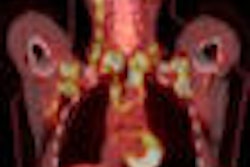SEATTLE - Whole-body PET detects 20% more cancers not found with other diagnostic tests in patients with suspected paraneoplastic neurological disorders, researchers reported at the 2009 American Academy of Neurology (AAN) meeting.
Researchers from the Mayo Clinic in Rochester, MN, administered PET scans to patients who had received negative diagnoses based on other tests, ranging from physical exams to other imaging modalities, including mammography, ultrasound, and CT, said Dr. Andrew McKeon, a fellow in the department of neurology at the Mayo Clinic.
The researchers reviewed the medical records of 56 consecutive patients with suspected paraneoplastic neurological disorders who underwent PET scanning at their institution between 2005 and 2008. Fifty percent of patients were male, and the median age at onset of neurological symptoms was 61 years.
To be included in the study, patients had to have suspected paraneoplastic disorders and one or more of the following: acute or subacute symptom onset (61%), history of cancer (18%) or smoking (39%), paraneoplastic antibodies detected (70%), and inflammatory cerebrospinal fluid (37%). Patients who met the inclusion criteria received a whole-body PET scan.
PET revealed abnormalities suggesting cancer in 22 patients (40%). In 11 patients (20%), the cancers were confirmed histologically. In 10 (91%) of the 11 patients, the cancer was limited to one anatomic site. In six (55%) of the patients, the cancer was outside the scope of CT, McKeon said. These cases included two thyroid papillary carcinomas, one thyroid Hurthle cell tumor, and one tonsil squamous cell carcinoma.
"The diagnostic yield was greatest in patients with a neuronal nuclear or cytoplasmic marker autoantibody," he said.
The presence of neuronal nuclear or cytoplasmic antibodies was detected by immunofluoroscopy in seven (64%) of 11 of patients with cancer, compared with seven (16%) of 45 patients without cancer. The difference was highly significant (p < 0.003), McKeon reported.
Spinal fluid inflammatory markers, including oligoclonal bands, pleocytosis, and elevated IgG index, were more common among patients with cancer or an inconclusive biopsy than among those with normal PET imaging or benign pathology on biopsy findings. Patient age, gender, neurological syndrome, smoking status, and cancer history were not predictive of a successful PET cancer search.
In response to a question from moderator Dr. Robert Zivadinov, Ph.D., professor of neurology at the State University of New York at Buffalo, McKeon said that adding the whole-body PET scan "doesn't take more time than whole-body CT."
McKeon said he hopes the study will help sway the debate over whether whole-body PET exams should receive Medicare and Medicaid reimbursement in the U.S.
"We hope these findings, combined with other literature already out there, will improve patients' chances of getting insurance coverage for whole-body PET," he said.
By Charlene Laino
AuntMinnie.com contributing writer
May 1, 2009
Related Reading
ASL MRI gains edge over PET in brain tumor follow-up, April 28, 2009
CMS expands PET Medicare coverage for cancer patients, April 3, 2009
CT for brain metastasis unnecessary after PET/CT, April 2, 2009
Copyright © 2009 AuntMinnie.com




















